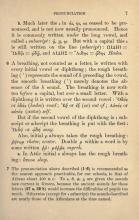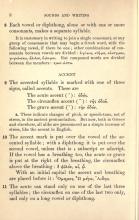2. Greek writing was phonetic—that is, the letters were meant to represent the sounds, and each sound was written.
a. But slight distinctions were disregarded, and an old spelling was sometimes kept after the sound had changed. Thus finally, in the Byzantine period and since, the spelling of many words became unphonetic.
3. The letter γ before κ, γ, χ, or ξ represents the sound of n in link, or ng in sing (γ nasal).
ἀνάγκη necessity
φθόγγος tone
ἄγχι near
4. The vowels ε and ο are always short—that is, were pronounced in less time than long vowels; η and ω are always long—that is, given more time in speaking; α, ι, and υ are sometimes long, sometimes short. In this grammar long ᾱ, ῑ, ῡ are marked with macrons; short are left unmarked.
5. The diphthongs (δί-φθογγοι of two vowels) are
| αι | ει | οι | αυ | ευ | ου | |
| ᾱι | ηι | ωι | ηυ | ωυ | υι |
a. Both vowels had their full sound, though united into one syllable. But by 400 B.C. ει and ου had become simple; ει represented the close sound of French é prolonged, or of German ee in Seele, and ου the close sound of u in rule or oo in food.
b. Much later the ι in ᾱι, ηι, ωι ceased to be pronounced, and is not now usually pronounced. Hence it is commonly written under the long vowel, and called ι subscript.
ᾳ, ῃ, ῳ
But with a capital this ι is still written on the line (adscript).
ΩΙΔHI = Ὠιδῆι = ᾠδῇ
ΑΙΔHΣ = Ἅιδης = ᾅδης (Hades)
6. A breathing, not counted as a letter, is written with every initial vowel or diphthong; the rough breathing (ʽ) represents the sound of h preceding the vowel, the smooth breathing (ʼ) merely denotes the absence of the h sound. The breathing is now written before a capital, but over a small letter. With a diphthong it is written over the second vowel.
Ὁδός οr ὁδός (hodos) road
Ἐξ or ἐξ (ex) out of
Aὐτός or αὐτός (autos) self
But if the second vowel of the diphthong is ι subscript or adscript the breathing is put with the first.
Ὠιδή οr ᾠδή song
Also, initial ρ always takes the rough breathing.
ῥήτωρ rhetor, orator
Double ρ within a word is sometimes written ῤῥ.
μύῤῥα myrrh
a. In Attic initial υ always has the rough breathing.
7. The pronunciation described above (§§ 1 and 2–6, above) is recommended as the nearest approach practicable, for our schools, to that of Athens about 400 B.C. To ε, θ, φ, and χ are given the sounds now current in Greece, because the ancient sounds for these letters (§§ 27.a, 38.b) would increase the difficulties of pupils too much. Otherwise (except for ι subscript) the sounds described are nearly those of the Athenians at the time named.
8. Each vowel or diphthong, alone or with one or more consonants, makes a separate syllable.
It is customary in writing to join a single consonant, or any group of consonants that may begin a Greek word, with the following vowel, if there is one; other combinations of consonants between vowels are divided.
ὑ-γί-ει-α
κτῆ-μα
κέ-κτη-μαι
γι-γνώ-σκω
ἄλ-λος
ὅ-ψο-μαι
But compound words are divided between the members.
προσ-ά-πτω



